Importance of Intercultural & Technological Communication Essay
VerifiedAdded on 2022/09/17
|6
|1310
|16
Essay
AI Summary
This essay delves into the critical importance of intercultural and technological communication within the professional sphere. It highlights how these communication forms are essential for managing a diverse workforce in an increasingly globalized environment. The paper discusses the challenges of cultural differences, stereotypes, and the impact of non-verbal communication, emphasizing the need for proactive assessment of communication skills by managers. It uses the example of Google to illustrate how organizations can foster open communication systems to address miscommunication arising from cultural barriers and promote a positive organizational culture. The essay concludes that effective intercultural and technological communication, supported by proper management policies, leads to increased efficiency, mutual trust, and respect for differences, ultimately contributing to a positive and collaborative workplace environment.
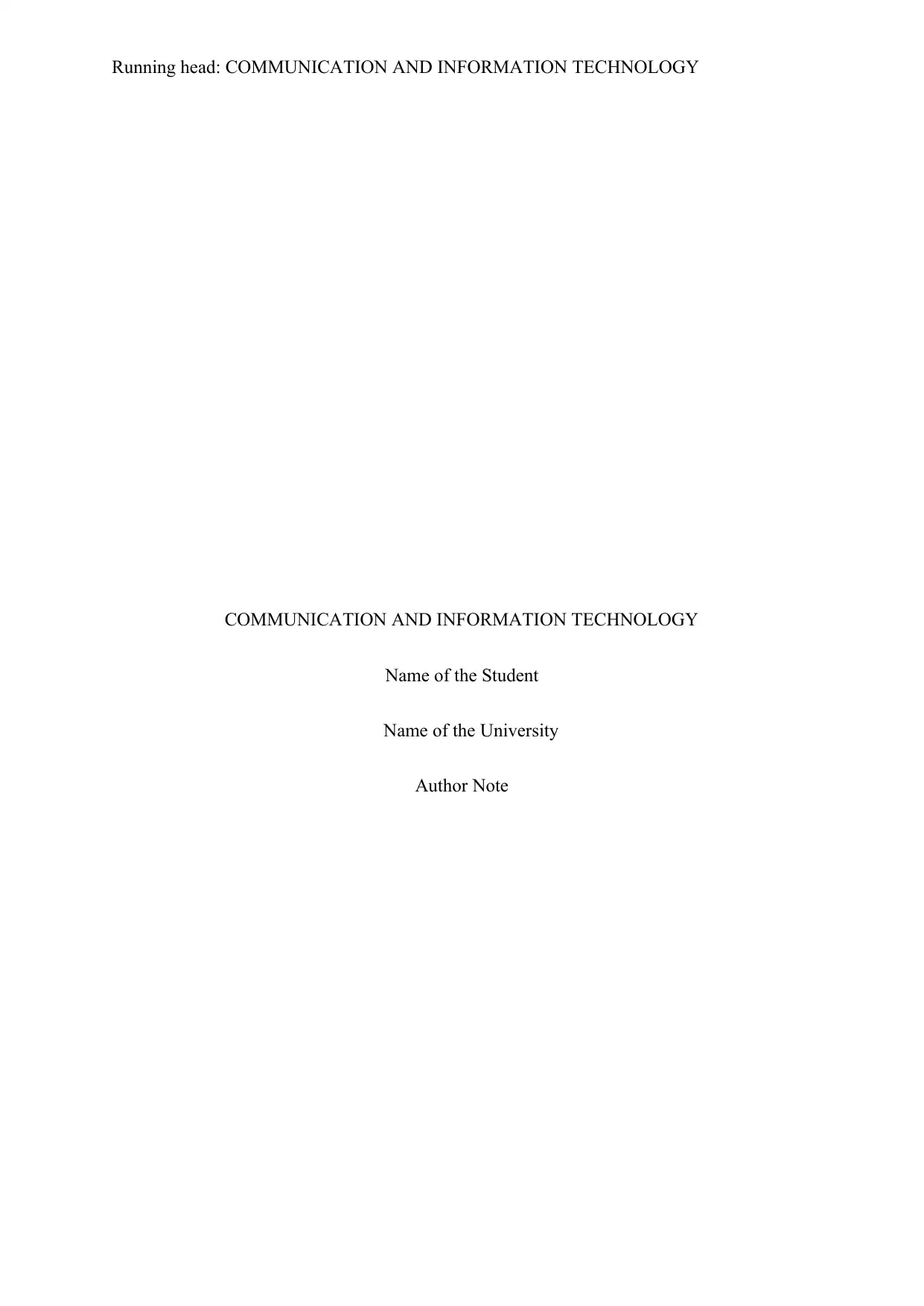
Running head: COMMUNICATION AND INFORMATION TECHNOLOGY
COMMUNICATION AND INFORMATION TECHNOLOGY
Name of the Student
Name of the University
Author Note
COMMUNICATION AND INFORMATION TECHNOLOGY
Name of the Student
Name of the University
Author Note
Paraphrase This Document
Need a fresh take? Get an instant paraphrase of this document with our AI Paraphraser
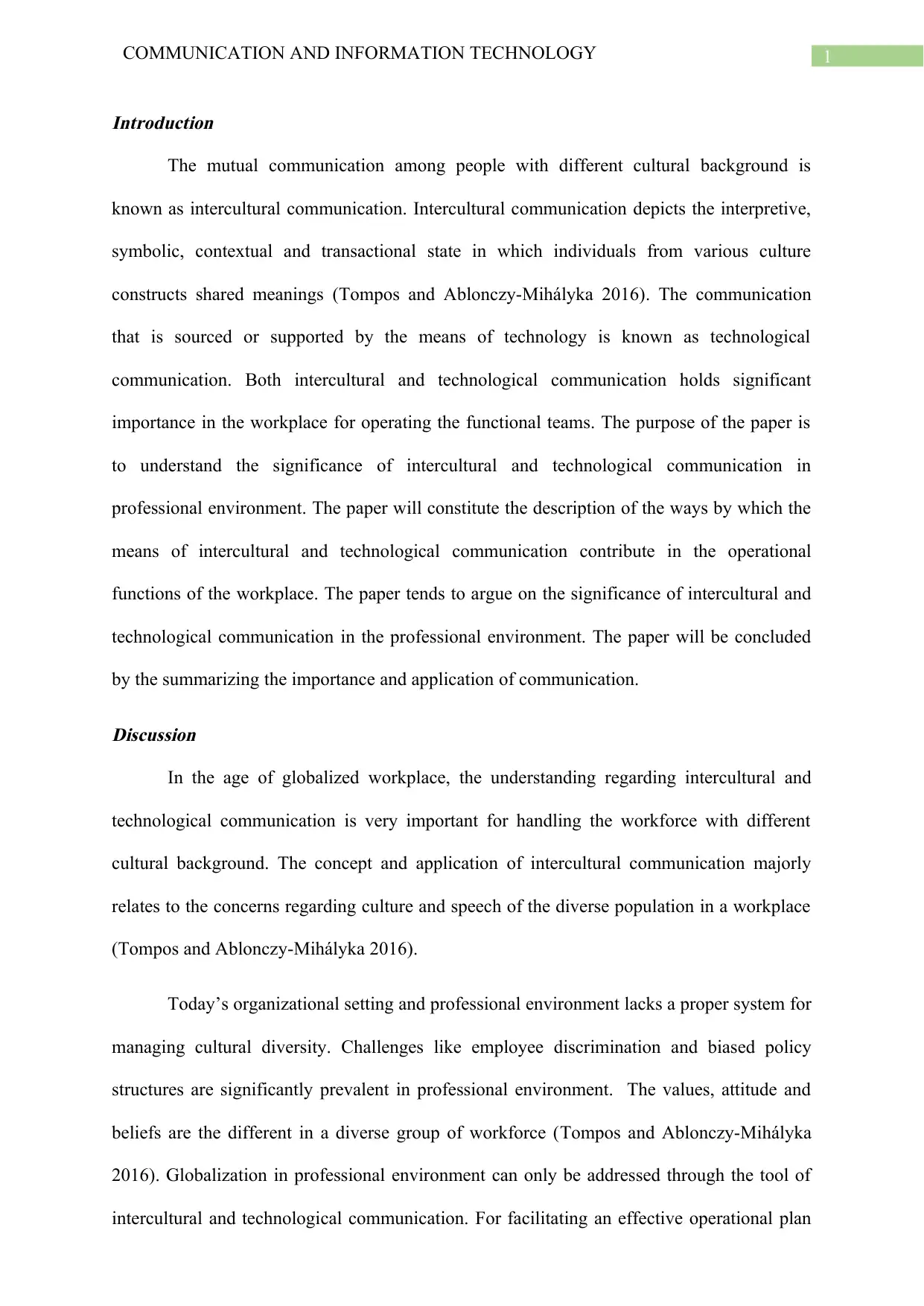
1COMMUNICATION AND INFORMATION TECHNOLOGY
Introduction
The mutual communication among people with different cultural background is
known as intercultural communication. Intercultural communication depicts the interpretive,
symbolic, contextual and transactional state in which individuals from various culture
constructs shared meanings (Tompos and Ablonczy-Mihályka 2016). The communication
that is sourced or supported by the means of technology is known as technological
communication. Both intercultural and technological communication holds significant
importance in the workplace for operating the functional teams. The purpose of the paper is
to understand the significance of intercultural and technological communication in
professional environment. The paper will constitute the description of the ways by which the
means of intercultural and technological communication contribute in the operational
functions of the workplace. The paper tends to argue on the significance of intercultural and
technological communication in the professional environment. The paper will be concluded
by the summarizing the importance and application of communication.
Discussion
In the age of globalized workplace, the understanding regarding intercultural and
technological communication is very important for handling the workforce with different
cultural background. The concept and application of intercultural communication majorly
relates to the concerns regarding culture and speech of the diverse population in a workplace
(Tompos and Ablonczy-Mihályka 2016).
Today’s organizational setting and professional environment lacks a proper system for
managing cultural diversity. Challenges like employee discrimination and biased policy
structures are significantly prevalent in professional environment. The values, attitude and
beliefs are the different in a diverse group of workforce (Tompos and Ablonczy-Mihályka
2016). Globalization in professional environment can only be addressed through the tool of
intercultural and technological communication. For facilitating an effective operational plan
Introduction
The mutual communication among people with different cultural background is
known as intercultural communication. Intercultural communication depicts the interpretive,
symbolic, contextual and transactional state in which individuals from various culture
constructs shared meanings (Tompos and Ablonczy-Mihályka 2016). The communication
that is sourced or supported by the means of technology is known as technological
communication. Both intercultural and technological communication holds significant
importance in the workplace for operating the functional teams. The purpose of the paper is
to understand the significance of intercultural and technological communication in
professional environment. The paper will constitute the description of the ways by which the
means of intercultural and technological communication contribute in the operational
functions of the workplace. The paper tends to argue on the significance of intercultural and
technological communication in the professional environment. The paper will be concluded
by the summarizing the importance and application of communication.
Discussion
In the age of globalized workplace, the understanding regarding intercultural and
technological communication is very important for handling the workforce with different
cultural background. The concept and application of intercultural communication majorly
relates to the concerns regarding culture and speech of the diverse population in a workplace
(Tompos and Ablonczy-Mihályka 2016).
Today’s organizational setting and professional environment lacks a proper system for
managing cultural diversity. Challenges like employee discrimination and biased policy
structures are significantly prevalent in professional environment. The values, attitude and
beliefs are the different in a diverse group of workforce (Tompos and Ablonczy-Mihályka
2016). Globalization in professional environment can only be addressed through the tool of
intercultural and technological communication. For facilitating an effective operational plan
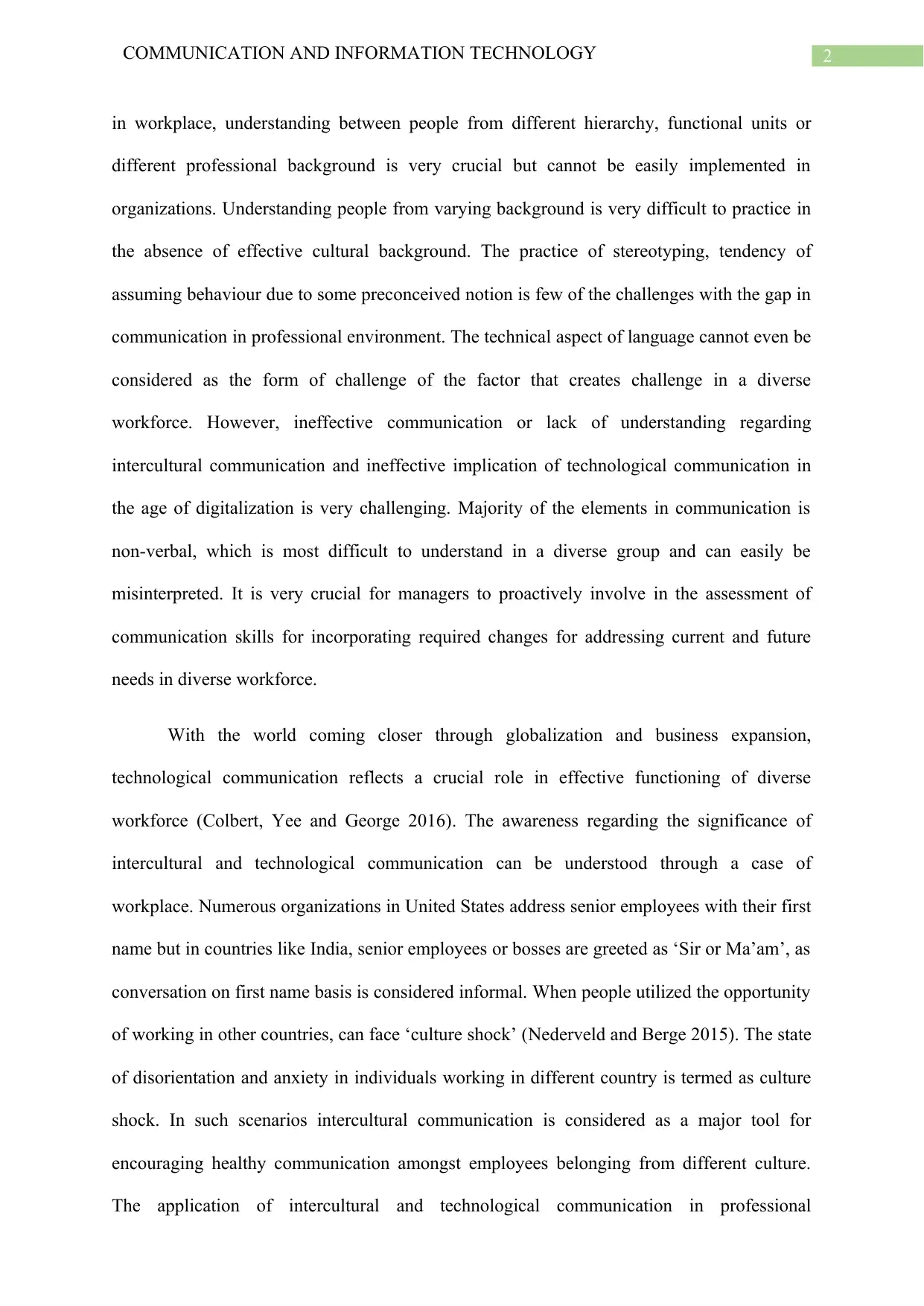
2COMMUNICATION AND INFORMATION TECHNOLOGY
in workplace, understanding between people from different hierarchy, functional units or
different professional background is very crucial but cannot be easily implemented in
organizations. Understanding people from varying background is very difficult to practice in
the absence of effective cultural background. The practice of stereotyping, tendency of
assuming behaviour due to some preconceived notion is few of the challenges with the gap in
communication in professional environment. The technical aspect of language cannot even be
considered as the form of challenge of the factor that creates challenge in a diverse
workforce. However, ineffective communication or lack of understanding regarding
intercultural communication and ineffective implication of technological communication in
the age of digitalization is very challenging. Majority of the elements in communication is
non-verbal, which is most difficult to understand in a diverse group and can easily be
misinterpreted. It is very crucial for managers to proactively involve in the assessment of
communication skills for incorporating required changes for addressing current and future
needs in diverse workforce.
With the world coming closer through globalization and business expansion,
technological communication reflects a crucial role in effective functioning of diverse
workforce (Colbert, Yee and George 2016). The awareness regarding the significance of
intercultural and technological communication can be understood through a case of
workplace. Numerous organizations in United States address senior employees with their first
name but in countries like India, senior employees or bosses are greeted as ‘Sir or Ma’am’, as
conversation on first name basis is considered informal. When people utilized the opportunity
of working in other countries, can face ‘culture shock’ (Nederveld and Berge 2015). The state
of disorientation and anxiety in individuals working in different country is termed as culture
shock. In such scenarios intercultural communication is considered as a major tool for
encouraging healthy communication amongst employees belonging from different culture.
The application of intercultural and technological communication in professional
in workplace, understanding between people from different hierarchy, functional units or
different professional background is very crucial but cannot be easily implemented in
organizations. Understanding people from varying background is very difficult to practice in
the absence of effective cultural background. The practice of stereotyping, tendency of
assuming behaviour due to some preconceived notion is few of the challenges with the gap in
communication in professional environment. The technical aspect of language cannot even be
considered as the form of challenge of the factor that creates challenge in a diverse
workforce. However, ineffective communication or lack of understanding regarding
intercultural communication and ineffective implication of technological communication in
the age of digitalization is very challenging. Majority of the elements in communication is
non-verbal, which is most difficult to understand in a diverse group and can easily be
misinterpreted. It is very crucial for managers to proactively involve in the assessment of
communication skills for incorporating required changes for addressing current and future
needs in diverse workforce.
With the world coming closer through globalization and business expansion,
technological communication reflects a crucial role in effective functioning of diverse
workforce (Colbert, Yee and George 2016). The awareness regarding the significance of
intercultural and technological communication can be understood through a case of
workplace. Numerous organizations in United States address senior employees with their first
name but in countries like India, senior employees or bosses are greeted as ‘Sir or Ma’am’, as
conversation on first name basis is considered informal. When people utilized the opportunity
of working in other countries, can face ‘culture shock’ (Nederveld and Berge 2015). The state
of disorientation and anxiety in individuals working in different country is termed as culture
shock. In such scenarios intercultural communication is considered as a major tool for
encouraging healthy communication amongst employees belonging from different culture.
The application of intercultural and technological communication in professional
⊘ This is a preview!⊘
Do you want full access?
Subscribe today to unlock all pages.

Trusted by 1+ million students worldwide
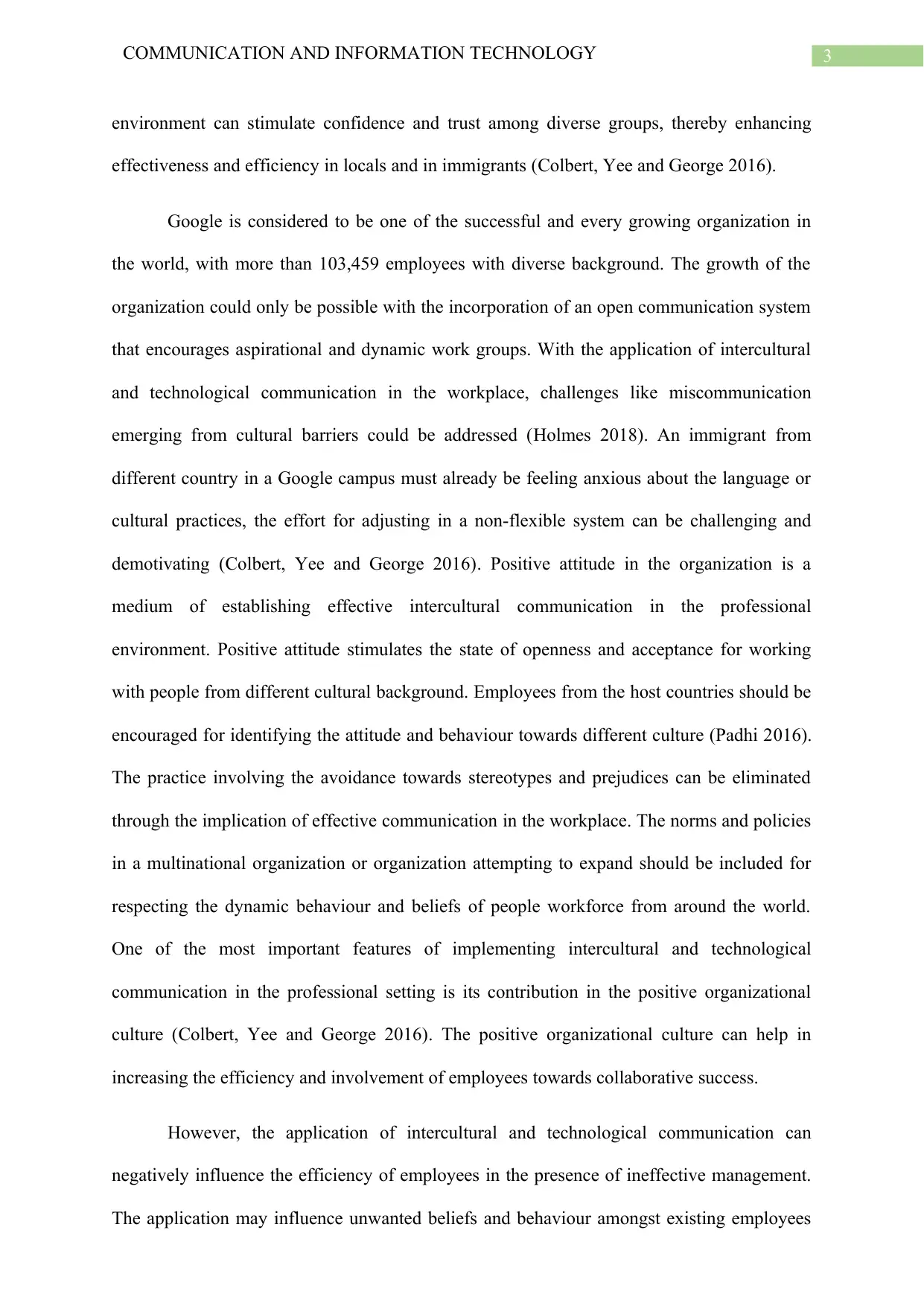
3COMMUNICATION AND INFORMATION TECHNOLOGY
environment can stimulate confidence and trust among diverse groups, thereby enhancing
effectiveness and efficiency in locals and in immigrants (Colbert, Yee and George 2016).
Google is considered to be one of the successful and every growing organization in
the world, with more than 103,459 employees with diverse background. The growth of the
organization could only be possible with the incorporation of an open communication system
that encourages aspirational and dynamic work groups. With the application of intercultural
and technological communication in the workplace, challenges like miscommunication
emerging from cultural barriers could be addressed (Holmes 2018). An immigrant from
different country in a Google campus must already be feeling anxious about the language or
cultural practices, the effort for adjusting in a non-flexible system can be challenging and
demotivating (Colbert, Yee and George 2016). Positive attitude in the organization is a
medium of establishing effective intercultural communication in the professional
environment. Positive attitude stimulates the state of openness and acceptance for working
with people from different cultural background. Employees from the host countries should be
encouraged for identifying the attitude and behaviour towards different culture (Padhi 2016).
The practice involving the avoidance towards stereotypes and prejudices can be eliminated
through the implication of effective communication in the workplace. The norms and policies
in a multinational organization or organization attempting to expand should be included for
respecting the dynamic behaviour and beliefs of people workforce from around the world.
One of the most important features of implementing intercultural and technological
communication in the professional setting is its contribution in the positive organizational
culture (Colbert, Yee and George 2016). The positive organizational culture can help in
increasing the efficiency and involvement of employees towards collaborative success.
However, the application of intercultural and technological communication can
negatively influence the efficiency of employees in the presence of ineffective management.
The application may influence unwanted beliefs and behaviour amongst existing employees
environment can stimulate confidence and trust among diverse groups, thereby enhancing
effectiveness and efficiency in locals and in immigrants (Colbert, Yee and George 2016).
Google is considered to be one of the successful and every growing organization in
the world, with more than 103,459 employees with diverse background. The growth of the
organization could only be possible with the incorporation of an open communication system
that encourages aspirational and dynamic work groups. With the application of intercultural
and technological communication in the workplace, challenges like miscommunication
emerging from cultural barriers could be addressed (Holmes 2018). An immigrant from
different country in a Google campus must already be feeling anxious about the language or
cultural practices, the effort for adjusting in a non-flexible system can be challenging and
demotivating (Colbert, Yee and George 2016). Positive attitude in the organization is a
medium of establishing effective intercultural communication in the professional
environment. Positive attitude stimulates the state of openness and acceptance for working
with people from different cultural background. Employees from the host countries should be
encouraged for identifying the attitude and behaviour towards different culture (Padhi 2016).
The practice involving the avoidance towards stereotypes and prejudices can be eliminated
through the implication of effective communication in the workplace. The norms and policies
in a multinational organization or organization attempting to expand should be included for
respecting the dynamic behaviour and beliefs of people workforce from around the world.
One of the most important features of implementing intercultural and technological
communication in the professional setting is its contribution in the positive organizational
culture (Colbert, Yee and George 2016). The positive organizational culture can help in
increasing the efficiency and involvement of employees towards collaborative success.
However, the application of intercultural and technological communication can
negatively influence the efficiency of employees in the presence of ineffective management.
The application may influence unwanted beliefs and behaviour amongst existing employees
Paraphrase This Document
Need a fresh take? Get an instant paraphrase of this document with our AI Paraphraser
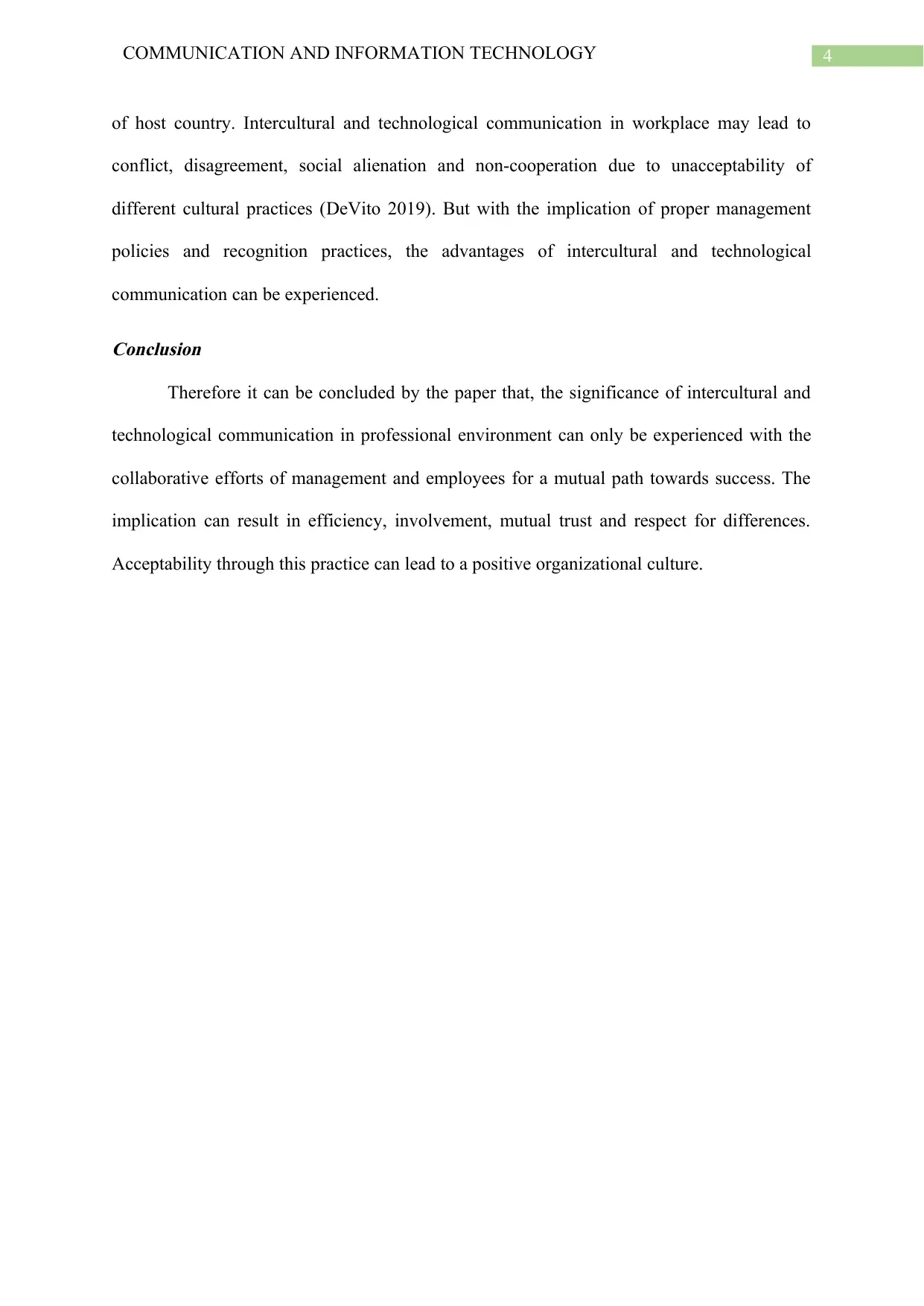
4COMMUNICATION AND INFORMATION TECHNOLOGY
of host country. Intercultural and technological communication in workplace may lead to
conflict, disagreement, social alienation and non-cooperation due to unacceptability of
different cultural practices (DeVito 2019). But with the implication of proper management
policies and recognition practices, the advantages of intercultural and technological
communication can be experienced.
Conclusion
Therefore it can be concluded by the paper that, the significance of intercultural and
technological communication in professional environment can only be experienced with the
collaborative efforts of management and employees for a mutual path towards success. The
implication can result in efficiency, involvement, mutual trust and respect for differences.
Acceptability through this practice can lead to a positive organizational culture.
of host country. Intercultural and technological communication in workplace may lead to
conflict, disagreement, social alienation and non-cooperation due to unacceptability of
different cultural practices (DeVito 2019). But with the implication of proper management
policies and recognition practices, the advantages of intercultural and technological
communication can be experienced.
Conclusion
Therefore it can be concluded by the paper that, the significance of intercultural and
technological communication in professional environment can only be experienced with the
collaborative efforts of management and employees for a mutual path towards success. The
implication can result in efficiency, involvement, mutual trust and respect for differences.
Acceptability through this practice can lead to a positive organizational culture.
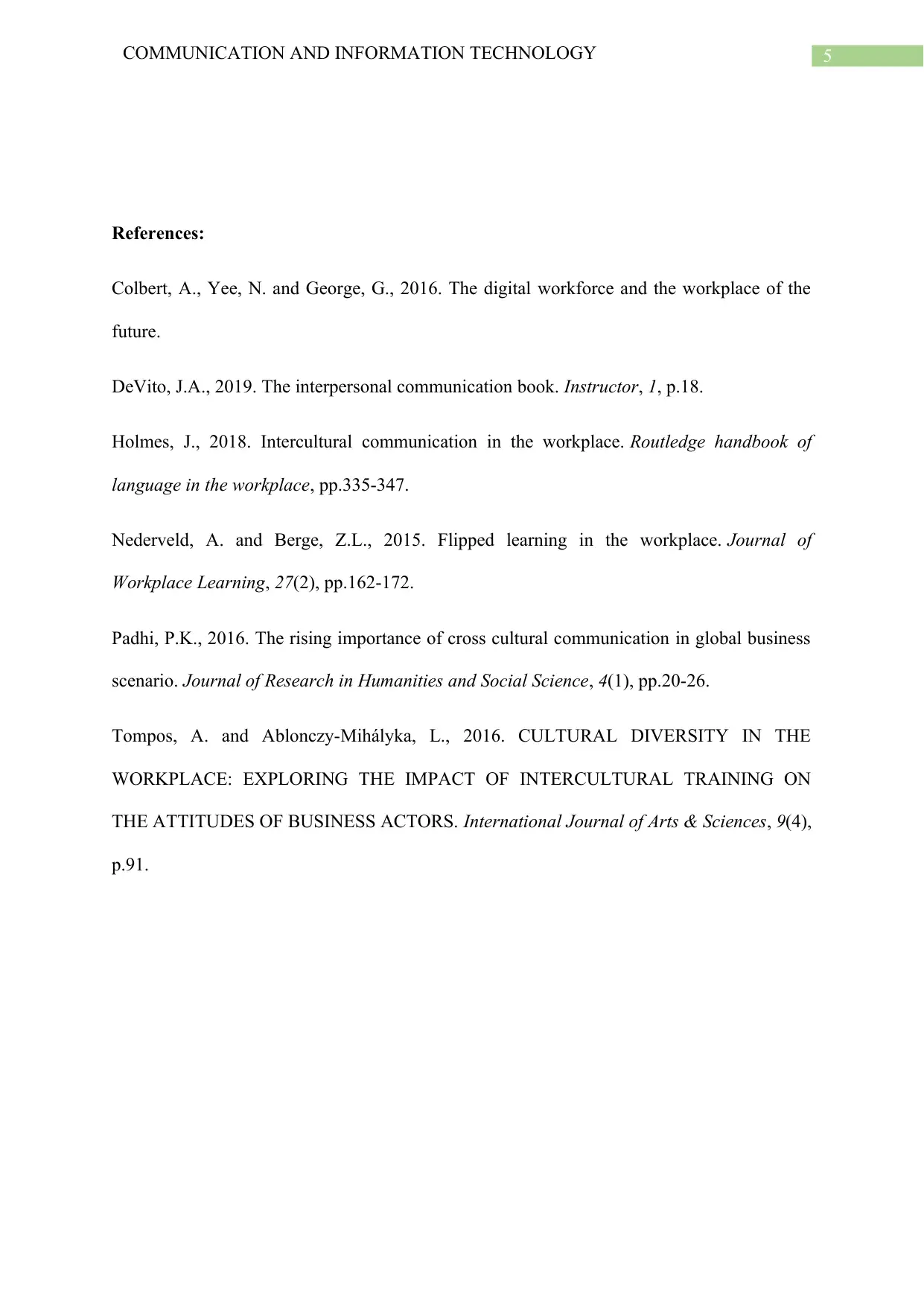
5COMMUNICATION AND INFORMATION TECHNOLOGY
References:
Colbert, A., Yee, N. and George, G., 2016. The digital workforce and the workplace of the
future.
DeVito, J.A., 2019. The interpersonal communication book. Instructor, 1, p.18.
Holmes, J., 2018. Intercultural communication in the workplace. Routledge handbook of
language in the workplace, pp.335-347.
Nederveld, A. and Berge, Z.L., 2015. Flipped learning in the workplace. Journal of
Workplace Learning, 27(2), pp.162-172.
Padhi, P.K., 2016. The rising importance of cross cultural communication in global business
scenario. Journal of Research in Humanities and Social Science, 4(1), pp.20-26.
Tompos, A. and Ablonczy-Mihályka, L., 2016. CULTURAL DIVERSITY IN THE
WORKPLACE: EXPLORING THE IMPACT OF INTERCULTURAL TRAINING ON
THE ATTITUDES OF BUSINESS ACTORS. International Journal of Arts & Sciences, 9(4),
p.91.
References:
Colbert, A., Yee, N. and George, G., 2016. The digital workforce and the workplace of the
future.
DeVito, J.A., 2019. The interpersonal communication book. Instructor, 1, p.18.
Holmes, J., 2018. Intercultural communication in the workplace. Routledge handbook of
language in the workplace, pp.335-347.
Nederveld, A. and Berge, Z.L., 2015. Flipped learning in the workplace. Journal of
Workplace Learning, 27(2), pp.162-172.
Padhi, P.K., 2016. The rising importance of cross cultural communication in global business
scenario. Journal of Research in Humanities and Social Science, 4(1), pp.20-26.
Tompos, A. and Ablonczy-Mihályka, L., 2016. CULTURAL DIVERSITY IN THE
WORKPLACE: EXPLORING THE IMPACT OF INTERCULTURAL TRAINING ON
THE ATTITUDES OF BUSINESS ACTORS. International Journal of Arts & Sciences, 9(4),
p.91.
⊘ This is a preview!⊘
Do you want full access?
Subscribe today to unlock all pages.

Trusted by 1+ million students worldwide
1 out of 6
Related Documents
Your All-in-One AI-Powered Toolkit for Academic Success.
+13062052269
info@desklib.com
Available 24*7 on WhatsApp / Email
![[object Object]](/_next/static/media/star-bottom.7253800d.svg)
Unlock your academic potential
Copyright © 2020–2025 A2Z Services. All Rights Reserved. Developed and managed by ZUCOL.





